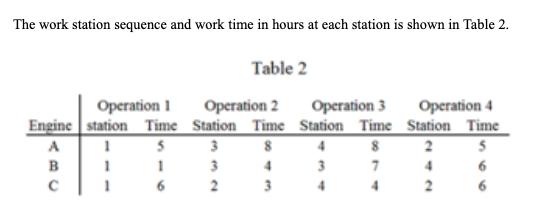Question
BCA as a sequence, make a Gantt Chart set forward finite VERTICAL problem of scheduling the various repair operations required on each engine. Four types

BCA as a sequence, make a Gantt Chart set forward finite VERTICAL
problem of scheduling the various repair operations required on each engine.
Four types of operations can be done on each engine; the specific sequence is unique to each engine and must be performed at a different station in the shop by a specialist mechanic. So, for example, one engine might require four operations in this sequence:
Station 1, Station 3, Station 4, Station 2
while another engine might require five operations in this sequence:
Station 2, Station 1, Station 3, Station 2, Station 4
Because of specialized equipment and labor skills, there is only one station of each type and mechanics cannot work at other stations. The nature of the technology is such that only one engine can be worked on at a station at any given time. Once an operation has begun it is extremely difficult, and very costly, to stop work and shift to another engine until that operation is complete.
Shop contracts with aircraft owners specify a fixed price for the complete repair/maintenance of each engine. Since most engines come from aircraft used for air taxi service, minimization of aircraft downtime is critical. Contracts therefore include a fixed due date for each engine based on estimates made when the work is assessed. If the due date is not met, contracts specify a penalty for each hour of delay past the due date.
On a typical Monday morning, three or four engines will have been accepted for repair/maintenance. The shop owner lays out a work schedule for these engines, trying to
maximize his profit. There are three engines awaiting repair this week:
engine A is due at shop hour 33
engine B is due at shop hour 26
engine C is due at shop hour 34.
Contract prices and delay penalties are shown in Table 1.
Engine | price | delay penalty per hour |
A | 1700 | 250 |
B | 1300 | 100 |
C | 1200 | 175 |
The work station sequence and work time in hours at each station is shown in Table 2.
Estimated total profit for a schedule is calculated based on total revenue (price) less each job's materials cost, direct labor costs, an allocated overhead cost equal to 50% of the sum of direct
labor and material costs, and any delay costs. For planning purposes, the shop owner uses a direct labor rate of $22 per hour. Estimated material costs for the three jobs on hand are $200 for engine A, $250 for engine B, and $210 for engine C.
In costing out a tentative scheduled direct labor costs are assessed against the total hours required in each station, including idle time if any. For example, if the last job completed in Station 3 is finished in hour 30, the direct labor cost for the station would be based on 30 hours.
The work station sequence and work time in hours at each station is shown in Table 2. Engine A B Operation 1 station Time 5 1 6 1 Table 2 Operation 2 Station Time 3 2 8 4 Operation 3 Station Time 8 7 3 Operation 4 Station Time 5 6 2 4 2
Step by Step Solution
3.31 Rating (160 Votes )
There are 3 Steps involved in it
Step: 1
To calculate the direct labor costs for each station based on the tentative schedule we need to cons...
Get Instant Access to Expert-Tailored Solutions
See step-by-step solutions with expert insights and AI powered tools for academic success
Step: 2

Step: 3

Ace Your Homework with AI
Get the answers you need in no time with our AI-driven, step-by-step assistance
Get Started


